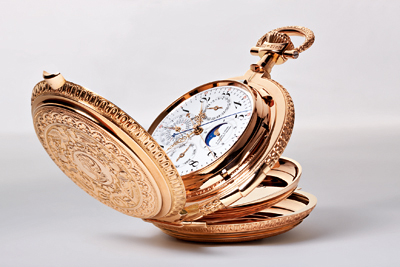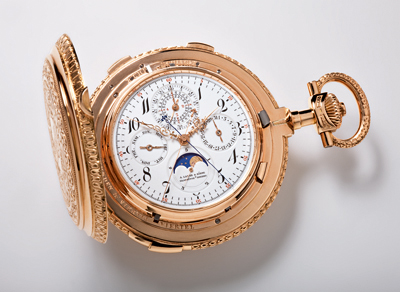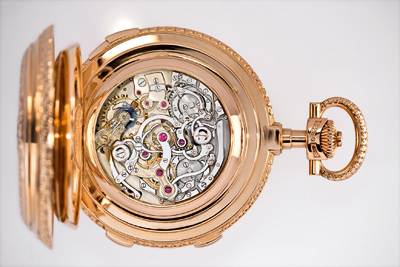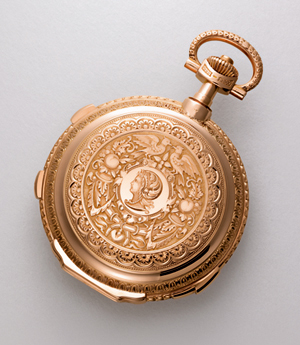Press release
Grands Complication 42500 © A. Lange & Söhne
In 2001, a dramatic incident changed the working life of Jan Sliva, head of the in-house studio for historic Lange pocket watches. A visitor of the manufactory had handed him an old pocket watch and asked for an appraisal. It was clear from the very first moment that this timepiece was an extraordinary one. It was particularly large and heavy, and its case was engraved with an intricate motif designed by Professor Graff.
But when Jan Sliva opened the artistically decorated caseback, what he saw sent shivers down his spine. He discovered a movement that at best could be called a “scrap heap”. All parts were grimy, many were rusted, some were missing altogether, others were broken or so heavily corroded that their original shape could merely be surmised. Only the consummately assembled eight-part enamel dial was, surprisingly, almost in mint condition.
It didn't take long for Jan Sliva to spot the serial number on a bridge: “42500”. According to the journals, it identified a unique treasure with probably the most complicated, rare, and historically significant calibre that had ever left the A. Lange & Söhne manufactory – and it was the only one of its kind. Pocket watch No. 42500 had been sold to a resident of Vienna for 5,600 marks in 1902. At that time, the sum was equivalent to the price of a stately house.

Grands Complication 42500 © A. Lange & Söhne
An inestimably precious junkyard
“This watch,” Jan Sliva explains today, “unites a host of fascinating complications. It incorporates a chiming mechanism with a grand strike and a small strike, a minute repeater, a split-seconds chronograph with a minute counter and flying seconds (seconde foudroyante), as well as a perpetual calendar with a moon-phase display. Its nickel-plated German silver movement in 1A quality consists of an incredible 833 parts. Together with the case, it weighs nearly 300 grams.” It was a watch of inestimable historic value and its restoration would justify any conceivable amount of effort. That much was clear to Jan Sliva at first sight.
The very poor condition of the watch raised a fundamental question: how should such a rare and complex masterpiece be dealt with? Should the watch be left in its present condition and exhibited “in the raw”?
For Jan Sliva and his colleagues, this was not really an option. Instead, they decided to study and document the functions and interactions of the individual components on the basis of what was left and to fully restore the functionality of all the mechanisms. “This is the only chance we had,” says the master watchmaker, “to preserve the ingenuity of our fathers and forefathers for coming generations. What good is a heap of rust, however authentic it might be, if no one knows what it once looked like and how it worked?”

Grands Complication 42500 © A. Lange & Söhne
The secrets of the 833 parts
Thus, the declared objective was to conserve as much of the original substance as possible and then to reinstate the function and beauty of the venerable movement. For starters, this meant heavy-duty research, because the watch harboured many secrets that would have to be arduously deciphered. It contained a number of parts whose function eluded even the experts. There were components of such intricacy that no one could imagine how they might have been crafted, and even advanced CAD software failed to provide clues. Other parts which would have to be replaced were so deteriorated that their original geometry could no longer be conjectured. Every layer that Jan Sliva exposed raised scores of new questions – for instance how to craft an unusual type of gong for which no specifications existed. In some cases, months went by before a satisfactory solution to a problem could be found. Sometimes, the first try was successful. But the watch has also kept a few secrets to this very day.

Grands Complication 42500 © A. Lange & Söhne
Magnificent comeback for a complicated star
In the end, it took until the year 2009 to restore pocket watch No. 42500 to its former splendour. At the SIHH 2010 in Geneva, it will be on public display for the first time. It is a breathtaking remnant of tradition that has come alive and a bridge that connects the ingenuity of the Lange watchmaking dynasty with the virtuosity of the current generation of watchmakers. Indeed, it is a monument of horological expertise and human passion. For Jan Sliva, however, this watch is something like the highlight of his horological career. “After this, I can't imagine what might still lie ahead,” he says. “Only very, very few people get a chance during their lifetime to restore such a treasure.” No. 42500 is his lifework, so to speak.




